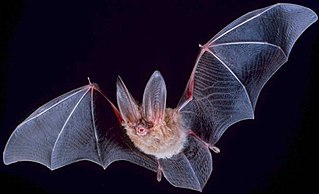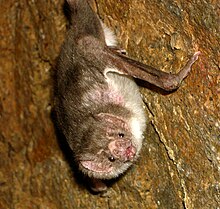
Microbats constitute the suborder Microchiroptera within the order Chiroptera (bats). Bats have long been differentiated into Megachiroptera (megabats) and Microchiroptera, based on their size, the use of echolocation by the Microchiroptera and other features; molecular evidence suggests a somewhat different subdivision, as the microbats have been shown to be a paraphyletic group.

Megabats constitute the family Pteropodidae of the order Chiroptera (bats). They are also called fruit bats, Old World fruit bats, or—especially the genera Acerodon and Pteropus—flying foxes. They are the only member of the superfamily Pteropodoidea, which is one of two superfamilies in the suborder Yinpterochiroptera. Internal divisions of Pteropodidae have varied since subfamilies were first proposed in 1917. From three subfamilies in the 1917 classification, six are now recognized, along with various tribes. As of 2018, 197 species of megabat had been described.

Tylopoda is a suborder of terrestrial herbivorous even-toed ungulates belonging to the order Artiodactyla. They are found in the wild in their native ranges of South America and Asia, while Australian feral camels are introduced. The group has a long fossil history in North America and Eurasia. Tylopoda appeared during the Eocene around 46.2 million years ago.

Chiromyiformes is an order of strepsirrhine primates that includes the aye-aye from Madagascar and its extinct relatives.

The simians, anthropoids or higher primates are an infraorder of primates containing all animals traditionally called monkeys and apes. More precisely, they consist of the parvorders New World monkeys (Platyrrhini) and Catarrhini, the latter of which consists of the superfamilies Old World monkeys in the stricter sense (Cercopithecidae) and apes.

Mystacinidae is a family of unusual bats, the New Zealand short-tailed bats. There is one living genus, Mystacina, with two species, one of which is believed to have become extinct in the 1960s. They are medium-sized bats, about 6 centimetres (2.4 in) in length, with grey, velvety fur.
In phylogenetics, basal is the direction of the base of a rooted phylogenetic tree or cladogram. The term may be more strictly applied only to nodes adjacent to the root, or more loosely applied to nodes regarded as being close to the root. Each node in the tree corresponds to a clade; i.e., clade C may be described as basal within a larger clade D if its root is directly linked to the root of D. The terms deep-branching or early-branching are similar in meaning.

Myzopoda, which has two described species, is the only genus in the bat family Myzopodidae. Myzopodidae is unique as the only family of bats presently endemic to Madagascar. However, fossil discoveries indicate that the family has an ancient lineage in Africa, extending from the Pleistocene as far back as the late Eocene. Based on nuclear DNA sequence data, Myzopodidae appears to be basal in the Gondwanan superfamily Noctilionoidea, most of whose members are neotropical. The origin and initial diversification of Noctilionoidea may have occurred in Africa prior to their dispersal to Australia and South America, probably via Antarctica. On the basis of fossil and molecular clock evidence, myzopodids are estimated to have split off from the rest of Noctilionoidea about 50 million years ago.
The Saint Bathans mammal is a currently unnamed extinct primitive mammal from the Early Miocene (Altonian) of New Zealand. A member of the Saint Bathans fauna, it is notable for being a late surviving "archaic" mammal species, neither a placental nor a marsupial. It also provides evidence that flightless fully terrestrial mammals did in fact once live in Zealandia. This is in contrast to modern New Zealand, where bats and seals are the only non-introduced mammals in the otherwise bird-dominated terrestrial faunas.
Witwatia is an extinct genus of giant bat that contained two species which lived in the Al Fayyum in Egypt during the late Eocene and one species which lived in Tunisia during the early Eocene. It is known from a lower jaw and teeth. Three species have been named: the type species W. schlosseri, W. eremicus and W. sigei.
Icarops is an extinct, possibly paraphyletic genus of mystacine bat with three described species. The genus is known from fossils found at Riversleigh, north-western Queensland, and Bullock Creek, Northern Territories, Australia. The fossils date from the late Oligocene to early Miocene.

Bats are mammals of the order Chiroptera. With their forelimbs adapted as wings, they are the only mammals capable of true and sustained flight. Bats are more manoeuvrable than most birds, flying with their very long spread-out digits covered with a thin membrane or patagium. The smallest bat, and arguably the smallest extant mammal, is Kitti's hog-nosed bat, which is 29–34 millimetres in length, 150 mm (6 in) across the wings and 2–2.6 g in mass. The largest bats are the flying foxes, with the giant golden-crowned flying fox, Acerodon jubatus, reaching a weight of 1.6 kg and having a wingspan of 1.7 m.
Karanisia is an extinct genus of strepsirrhine primate from middle Eocene deposits in Egypt.

Palaeochiropterygidae is a family of extinct bats. It was originally erected by the Swiss naturalist Pierre Revilliod in 1917 after discoveries of Palaeochiropteryx fossils from the Messel Pit of Germany. Palaeochiropterygidae was merged into Archaeonycteridae by Kurten and Anderson in 1980, but modern authorities specializing in bat fossils maintain the distinction between the two. It was classified to the unranked clade Microchiropteramorpha by Smith et al. in 2007.

The St Bathans fauna is found in the lower Bannockburn Formation of the Manuherikia Group of Central Otago, in the South Island of New Zealand. It comprises a suite of fossilised prehistoric animals from the late Early Miocene (Altonian) period, with an age range of 19–16 million years ago.

Hesham Sallam is an Egyptian paleontologist and the founder of the Mansoura University Vertebrate Paleontology Center (MUVP-C), the first vertebrate paleontology program in the Middle East. He works as an associate professor at the American University in Cairo and Mansoura University. Sallam led the discovery and description of Mansourasaurus shahinae, a species of sauropod dinosaur from Egypt, which has improved understanding of the prehistory of Africa during the latest Cretaceous period. His work has helped popularize paleontology in Egypt.
Vulcanops jennyworthyae is an extinct species of bat that lived during the Miocene in New Zealand, a large burrowing microchiropteran that probably ate arthropods and plant material around twenty million years before present. It is the type and only described species of the genus Vulcanops.
hAT transposons are a superfamily of DNA transposons, or Class II transposable elements, that are common in the genomes of plants, animals, and fungi.
Nancy B. Simmons is an American zoologist, mammalogist, professor, and author. Specializing in bats, Simmons has conducted extensive research on the morphology and evolutionary history of numerous bat species. She is also the curator-in-charge of the Department of Mammalogy at the American Museum of Natural History and a professor at the Richard Gilder Graduate School.
Onychonycteridae is an extinct family of bats known only from the early Eocene of Europe and North America. The type species, Onychonycteris finneyi, was described in 2008 from two nearly complete skeletons found in the Green River Formation of southwestern Wyoming. Since that time a number of previously described fossil bat species have been assigned to Onychonycteridae, as well as another more recently discovered species











